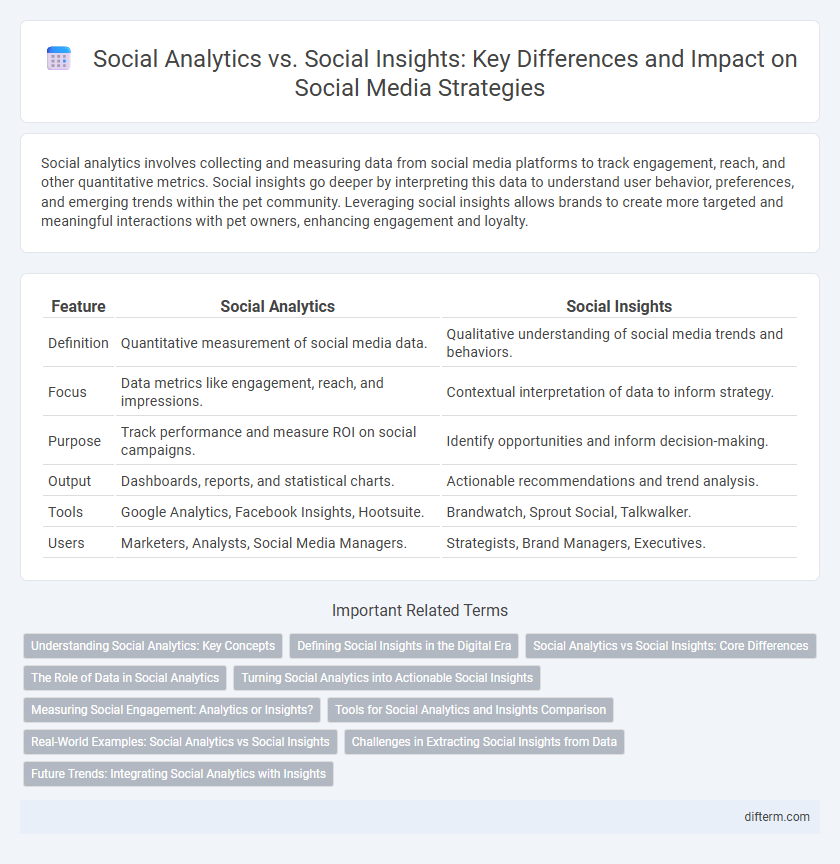Social analytics involves collecting and measuring data from social media platforms to track engagement, reach, and other quantitative metrics. Social insights go deeper by interpreting this data to understand user behavior, preferences, and emerging trends within the pet community. Leveraging social insights allows brands to create more targeted and meaningful interactions with pet owners, enhancing engagement and loyalty.
Table of Comparison
| Feature | Social Analytics | Social Insights |
|---|---|---|
| Definition | Quantitative measurement of social media data. | Qualitative understanding of social media trends and behaviors. |
| Focus | Data metrics like engagement, reach, and impressions. | Contextual interpretation of data to inform strategy. |
| Purpose | Track performance and measure ROI on social campaigns. | Identify opportunities and inform decision-making. |
| Output | Dashboards, reports, and statistical charts. | Actionable recommendations and trend analysis. |
| Tools | Google Analytics, Facebook Insights, Hootsuite. | Brandwatch, Sprout Social, Talkwalker. |
| Users | Marketers, Analysts, Social Media Managers. | Strategists, Brand Managers, Executives. |
Understanding Social Analytics: Key Concepts
Social analytics involves the systematic collection and analysis of data from social media platforms to measure user behavior, engagement metrics, and content performance. Key concepts include tracking sentiment analysis, audience demographics, and interaction patterns to quantify social media impact. Social insights, derived from this data, provide actionable understanding that helps shape marketing strategies and improve brand communication.
Defining Social Insights in the Digital Era
Social insights in the digital era refer to the deep understanding derived from analyzing social analytics data, encompassing patterns, behaviors, and sentiment across social media platforms. Unlike basic social analytics that involves tracking quantitative metrics such as likes, shares, and follower counts, social insights interpret these metrics to reveal customer motivations, preferences, and emerging trends. Leveraging AI and machine learning, organizations transform vast social data into actionable strategies that enhance brand engagement and drive targeted marketing campaigns.
Social Analytics vs Social Insights: Core Differences
Social analytics involves the collection and measurement of social data through metrics like engagement rates, reach, and impressions to evaluate performance. Social insights interpret this data to uncover patterns, customer behaviors, and emotional drivers that inform strategic decisions. The core difference lies in social analytics providing quantitative data, while social insights deliver qualitative understanding for actionable outcomes.
The Role of Data in Social Analytics
Data plays a crucial role in social analytics by collecting vast amounts of information from social media platforms, enabling the measurement of user behavior, engagement, and sentiment. Social analytics tools analyze this data to uncover patterns and trends, providing actionable insights that help organizations optimize marketing strategies and improve customer experience. Accurate and real-time data processing enhances decision-making, driving more effective social media campaigns and better brand management.
Turning Social Analytics into Actionable Social Insights
Social analytics involves collecting and measuring raw data from social media platforms, including engagement rates, impressions, and follower demographics. Turning social analytics into actionable social insights requires analyzing patterns and sentiment to understand audience behavior and preferences deeply. These insights enable businesses to optimize content strategies, enhance customer engagement, and drive targeted marketing decisions more effectively.
Measuring Social Engagement: Analytics or Insights?
Measuring social engagement involves analyzing metrics such as likes, shares, comments, and follower growth to quantify user interaction on platforms like Facebook, Instagram, and Twitter. Social analytics provides raw data and trends, while social insights interpret this data to reveal audience behavior, preferences, and sentiment. Leveraging social insights enables brands to make strategic decisions, optimize content, and foster deeper connections with their audience beyond basic engagement metrics.
Tools for Social Analytics and Insights Comparison
Social analytics tools like Hootsuite, Sprout Social, and Brandwatch enable real-time monitoring of engagement metrics, sentiment analysis, and audience demographics to track social media performance. Social insights platforms such as NetBase Quid and Talkwalker go beyond basic analytics by using AI-driven data interpretation to uncover trends, consumer behavior patterns, and predictive insights for strategic decision-making. Comparing these tools involves evaluating their data integration capabilities, depth of qualitative analysis, and visualization features to select the best solution for converting raw social data into actionable insights.
Real-World Examples: Social Analytics vs Social Insights
Social analytics tracks quantitative data such as engagement rates, follower growth, and sentiment analysis to measure social media performance. Social insights interpret this data to reveal consumer behavior patterns, market trends, and brand perception, enabling more informed strategic decisions. For example, a brand might use social analytics to identify a spike in mentions, while social insights help understand the reasons behind the spike, such as a viral campaign or a customer service issue.
Challenges in Extracting Social Insights from Data
Extracting social insights from data involves challenges such as handling vast volumes of unstructured information, ensuring data accuracy, and interpreting context-specific nuances in online behavior. Social analytics platforms must integrate advanced natural language processing and sentiment analysis to decode complex emotional cues and cultural references. Overcoming biases in data collection and algorithmic interpretation remains critical to generating reliable and actionable social insights.
Future Trends: Integrating Social Analytics with Insights
Integrating social analytics with social insights is shaping future trends by enabling brands to leverage real-time data for predictive consumer behavior modeling. Advanced AI algorithms and machine learning are enhancing the depth of insights derived from social media metrics, driving more personalized marketing strategies. This convergence supports proactive decision-making, optimizing customer engagement and brand loyalty in an increasingly competitive social landscape.
social analytics vs social insights Infographic

 difterm.com
difterm.com